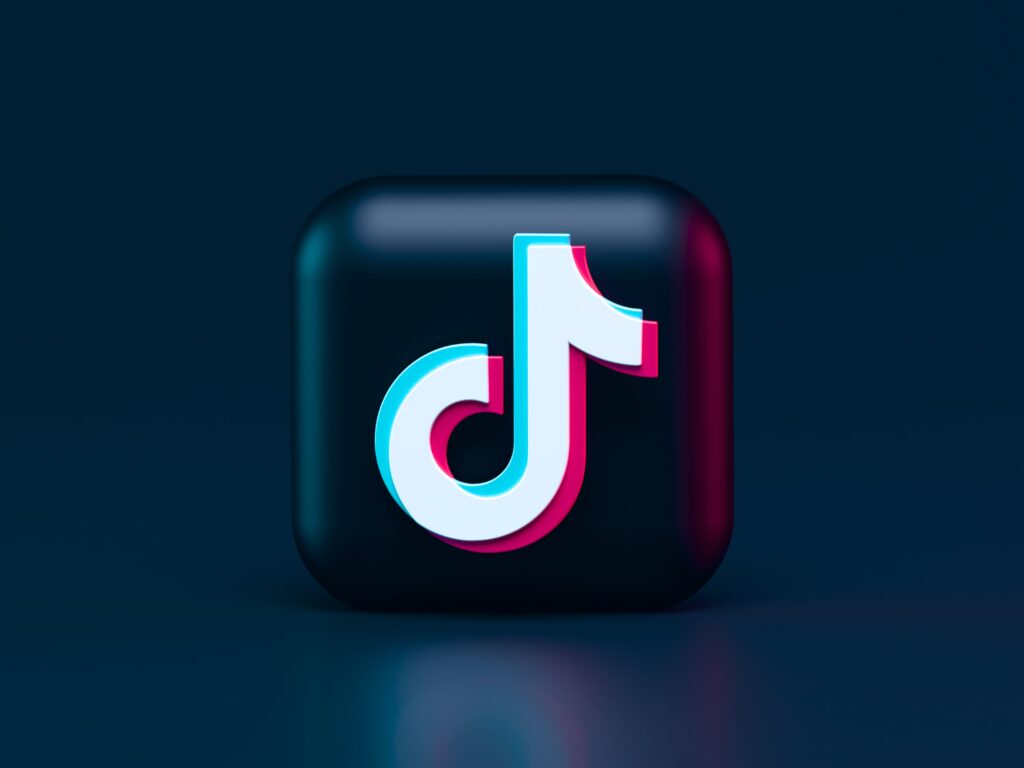What You Should Know if You’re Investing in the Platform
Developed in 2016, TikTok is the latest social media platform to be downloaded by millions around the world. But with this novelty, comes general uncertainty. Questions arise, such as: Just how popular is TikTok? Who’s on it? What exactly is TikTok? How is it used? And is it safe? The answers to these questions are especially vital to know as an advertiser, or anyone who has an invested interest in the app.
Photo by Alexander Shatov on Unsplash
The Newest Craze
CNBC reports that TikTok’s popularity has grown 800% in the U.S. since 2018, and 100 million Americans are active on the app (Sherman, 2020). With this astounding rate of growth and popularity, many businesses are beginning to use TikTok to increase their brand awareness.
And according to the social media management platform Hootsuite, TikTok is the sixth most popular social media, and was the fastest growing social media network of 2020 with 738 million app downloads (Sehl, 2020).
Even more attractive, TikTok is a truly global network, as there are upwards of 800 million active users across 150 different countries (para. 9)
Young User Base
Of this 800 million, 69% are 13 to 24 years-old, and gender is split 40/60 among males and females (para. 23). This makes TikTok’s user base the youngest in social media.
Furthermore, Pew Research Center conducted a survey asking parents if their kid, age 11 or younger, is on any social media. Despite its age restrictions, the survey concluded that TikTok is also the most popular in the 5 to 11 year-old age range, with 41% of parents saying that their kid is on TikTok (Auxier et al., 2020). In other words, Generation Z is the app’s primary consumer, with Generation Alpha likely to join them in the years to come.
So why is TikTok so popular, especially among the younger generations?
A Viral Video Machine
TikTok is akin to other popular social media apps, with Instagram and Snapchat being particularly similar. And in their own words, “TikTok is a place that brings people together to find moments of joy and inspiration. It’s also a place to find your community, no matter your interests” (TikTok, 2020). The platform primarily enables its users to share their daily experiences with others, expressing themselves through creatively edited short videos.
Each video published on this app is one to sixty seconds long, and are often accompanied by a barrage of vibrant edits and creative trends. When posted publicly, there is a nearly unlimited potential for how many impressions a TikTok can generate. This is all thanks to the app’s unique “For You” page, arguably the most viral-friendly algorithm on the internet.
This is something that especially differentiates TikTok from other social media platforms. The business magazine Entrepreneur emphasises the utility of this feature, reporting that “viral videos with huge engagement move to the front of the line and comprise the feed, and you’re served one video at a time” (Wolny, 2020). What this means is that TikTok facilitates an ideal environment for viral content. And not only do popular TikToks undergo a steep snowball effect, but users are specially delivered one TikTok at a time to watch. This is an important piece of information for businesses who wish to distinguish themselves with viral advertisements, as any competing content clutter is significantly reduced.
To put it simply, this social media platform is of great utility for both its casual and business users alike. TikTok consistently churns out viral content, and surprisingly, much of it is created by very ordinary people.
But what type of content usually goes viral on TikTok?
A Means for Entertainment
As the Harvard Political Review explains, “TikTok has retained much of its early culture, when it was simply teens having fun. All videos are filmed with cell phone cameras, and even the most famous TikTokers will film in dirty bathrooms with poor lighting (Keselj, 2020). Essentially, it is an app predominately used by teens and young adults, both actively creating and consuming the entertainment. TikTok also enables its users to share a slice of their life that other online mediums fall short of.
Photo by Carol Magalhães on Unsplash
The article goes on to say that TikTok allows users to “create a form of social media closer to real life than competitors”, and that “imperfections and authenticity are to be desired” (para. 6). Because of how personal many of the app’s content is, the most universally beloved TikToks are usually the most genuine and organic ones.
Possibly the best example of this comes from Nathan Apodaca, also known as “420doggface208” on TikTok. His most famous TikTok currently has 79.3 million views, and is ranked second overall on TikTok’s website for 2020’s most viral videos (TikTok, 2020). The video iconically features the 37 year-old father of two skateboarding alongside traffic, a jug of cranberry juice, and of course, FleetWood Mac.
The Los Angeles Times attributes his success to “his use of throwback tracks and happy-go-lucky perspective on life” (Zornosa, 2020). It wasn’t anything flashy or exuberant. There were no special effects, or anything out of the ordinary. It was widely celebrated nonetheless for its down-to-earth and wholesome content. Its refreshingly simple, relatable and authentic nature continues to resonate with millions of people around the world, and on a seemingly innate level of adoration.
As Apodaca exemplifies, TikTok does not require a professional setup or any technical skills to go viral and become a cultural icon. Conversely, many online platforms that specialize in video production can’t offer the same degree of simplicity that TikTok can. Thus, this is why content marketing strategist Nick Wolny characterizes TikTok as “the new Instagram” (para. 4). Just as Instagram gave ordinary people the toolset necessary to become polished photographers, TikTok’s intuitive editing software has given millions the opportunity to be at-home videographers.
Overall, most content created on TikTok is for entertainment purposes. This includes a wide-range of categories of interest such as #Dance, #Comedy, #Sports, #LifeHacks, #Food, #Pets and #Music. And hundreds of more popular hashtags exist, most of which are very specific and niche oriented. The resulting audience fragmentation helps create a multitude of smaller communities.
TikTok’s “Discover” page allows users to subscribe to specific content, which is geared towards their unique interests. Additionally, popular and relevant hashtags are recommended on the ‘Discover’ page. Currently, #MakeBlackHistory is front and center because of its relevance to Black History Month.
A Means for News
And on that note, it is important to mention that TikTok is not only empowering its users to create and enjoy content that is entertaining, but also informative. This can be useful to know when considering a target audience on the platform, especially for a social marketing campaign.
TikTok has been a useful source for news stories and socio-political commentary, especially as of lately. Research conducted by the Pew Research Center (2020) reported that 22% of TikTokers regularly use the site to get news (Shearer & Mitchell, 2021). While social media news consumption is still dominated by Twitter and Facebook, TikTok offers a healthy dose of political discourse that cannot be understated. This expansive melting pot of diverse perspectives contributes to the multifaceted culture within the TikTik community.
Maria Keselj from the Harvard Political Review says that TikTok is different when it comes to sharing news, explaining that “TikTok amplifies a variety of unique perspectives… Despite privilege and fame still being extremely visible on TikTok, they are significantly less dominant than on current social media titans and their predecessors” (para. 5). Many social media giants are constantly criticized for algorithm bias, or celebrity favoritism. But according to Keselj, TikTok and it’s ‘For You’ page deviates from that standard.
TikTok is different because it especially values diverse content, providing various cultural and ideological perspectives to every user. This uniquely thought-provoking content, facilitated by TikTok’s ‘For You” page, is undoubtedly a noteworthy aspect of the social media platform. Keselj further articulates:
[The ‘For You’ page] makes TikTok a more grassroots platform – the app promotes all creators, not just the famous, by giving them all chances on the ‘For You’ page. Going viral on TikTok is significantly easier than on other platforms, because advertising or an existing follower base are not needed to get exposure. (para. 5)
TikTok’s ability to create amateur and semi-pro videographers grants every user the power to be a news reporter. People can easily share first-hand, point-of-view experiences from any grassroot movement they have been a part of, and even more so with the help of useful hashtags. These highly newsworthy TikToks then have the capability of matching the nationwide reach of any news agency, because no prior TikTok following or account popularity is necessary for content to go viral.
Photo by Alex Radelich on Unsplash
Advertisers can also find this information profoundly useful, because again, no prior TikTok following or account popularity is necessary for content to go viral.
Many businesses will inevitably flock to TikTok with zero following and minimal experience with the social media platform. But even at an account’s bare infancy, every post that is published will have home run potential.
With numerous online media benefits and tech innovations, it should make sense why TikTok is the fastest growing social media network in the world. However, its popularity and influence has become so prevalent, that some governments and legislators have attempted to regulate TikTok’s growth.
TikTok’s Ban
As reported by Bloomberg, “the Trump administration labeled the app a security threat and banned the service last year, contending the Chinese government could compel ByteDance to turn over the data of millions of young American users” (Huang, 2021). Social media corporations and personal data have had a complicated relationship in recent years. A recent example of this is from 2019, when Facebook illegally sold data to the political consulting firm Cambridge Analytica.
Some might believe that it isn’t too far-fetched to assume that TikTok is just another untrustworthy tech company. But others believe it’s nothing more than hysteria, possibly fueled by xenophobia against the Chinese-based corporation.
Regardless of what anyone’s opinion might be, TikTok is no stranger to legislative regulations. Consequently, a decrease of popularity and active users could ensue, limiting the overall exposure TikToks can have. This is of course of major concern for businesses wanting to advertise on the app.
But with Trump now out of office, Huang shows some optimism for TikTok’s longevity in the U.S., writing that “Biden’s immediate priorities are curbing the pandemic and resuscitating the economy, and he has had little to say so far about TikTok” (para. 7). It is still difficult to say if TikTok’s security concerns will resurface in American politics, but it does not seem to be an immediate concern for the Biden administration.
India however has followed through with a total ban on TikTok. According to CNN, TikTok had 120 million users from India, and just laid off about 2,000 Indian employees as a result of the massive loss (Toh, 2021). With TikTok losing India’s densely populated market and pool of employees, their future growth, reach and overall potential becomes questionable.
India’s government describes TikTok as a “threat to sovereignty and integrity” (as cited in CNN), but China and India’s prior political conflict could actually be the underlying cause for the nationwide ban. India is currently in the process of banning 59 popular Chinese apps in total, and have adopted these anti-China policies since their Himalayaian conflict with them last summer (para. 11). The truth is still inconclusive, and it is unknown if TikTok will ever make a comeback in India. But China’s role in world affairs, whether warranted or not, has been creating controversy that is negatively impacting TikTok’s projections.
Ultimately, TikTok has shown more vulnerability than other social media platforms. While it’s certainly one of the most entertaining and creative mediums online, businesses need to seriously consider TikTok’s at-risk sustainability when incorporating it into their marketing strategy.
What This All Means for Advertisers
To recap,
- TikTok is a major social media platform (sixth largest overall) with 800 million active users worldwide.
- It’s a diverse, global user base, spread across 150 different countries.
- Its demographic is primarily Gen-Z, with 69% of its users being between the ages of 13 and 24.
- TikTok actively promotes viral videos on the ‘For You’ page, which is ideal for viral marketing and maximising ad exposure.
- The ‘For You’ page shows only one TikTok at a time, eliminating more content clutter than other social media.
- TikTok arguably gives creators the most potential to go viral.
- Most videos are made with a simple and imperfect style, in which any sort of professional production is unnecessary.
- Many popular videos on TikTok are favored for being genuine and wholesome, in other words, it allows people to be themselves.
- Can accurately target audiences by using relevant hashtags on the ‘Discover’ page. Many small communities exist throughout TikTok.
- Many TikToks welcome thought-provoking content and engagement.
- Many TikToks are organic, grassroot content.
- Diversity and new perspectives are encouraged on the ‘For You’ page.
- TikTok doesn’t require a large following or account popularity to go viral. It’s a level playing field.
- The U.S. government has expressed concern for the app’s alleged security threats, and India has recently banned the app entirely.
- The long-term success of TikTok as a viable social media platform might largely depend on the Chinese government’s world affairs.
Photo by William Iven on Unsplash
So, does TikTok fit into your marketing strategy?
TikTok For Business
If the answer is yes, TikTok conveniently offers “TikTok For Business” for the more serious advertisers.
Also referred to as “TikTok Ads Manager”, the website describes this feature as “where businesses of all kinds can set up a profile, build brand presence with organic content, and grow their business through a variety of tools” (TikTok, 2020). This is similar to most other social media business accounts which will provide in-depth metrics of each ad’s performance.
Social media management platform Later, lists five types of advertisements available on ‘TikTok For Business’:
In-Feed Ads
- The most basic and affordable option.
- Same as any other TikTok you’ll find throughout the ‘For You’ page, with the added benefit of attaching links and other contact information.
Brand Takeover
- Has the most to offer, but at the highest cost.
- Instantly pops up on a user’s TikTok app as soon as it is opened.
- Offers pure exclusivity. Only one brand per target audience can use the Brand Takeover each day.
TopView Ads
- Does not instantly pop up on a user’s app.
- Waits until they are on the ‘For You’ page, and then plays the ad after three seconds.
Hashtag Challenge
- TikTok will promote your business through a sponsored hashtag.
- Creates a high-level of engagement with your target audience.
- Can be the most fun and interactive option.
- Can save money by having TikTok influencers use your hashtag.
Branded Effects
- TikTok will promote any filters, lenses or stickers you create for your business.
- Similar to Hashtag Challenge advertising, Branded Effects can encourage a high-level engagement with your audience (Worb, 2020).
For these services, Katie Worb reports that TikTok charges a minimum of $500 for a campaign budget, and a minimum of $50 for an ad group budget (para. 26). She also says that “advertising on TikTok can be anywhere from $50,000 to $120,000, depending on the type and duration” (para. 27). There are a variety of price point options for businesses to consider, offering maximum flexibility as an advertiser.
But because TikTok is such a massive community, and actively promotes organic, viral content, many business advertisements can find success without having a costly budget.
Sources
Auxier, B., Anderson, M., Perrin, A., & Turner, E. (2020, August 27). Children’s engagement with
digital devices, screen time. Pew Research Center: Internet, Science & Tech.
https://www.pewresearch.org/internet/2020/07/28/childrens-engagement-with-digital-devi
ces-screen-time/?utm_content=buffer2345a&utm_medium=social&utm_source=twitter.c
om&utm_campaign=buffer.
Huang, Z. (2021, January 26). TikTok’s Owner Doubles Sales to $35 Despite U.S. Ban.
Bloomberg. https://www.bloomberg.com/news/articles/2021-01-27/tiktok-owner-s-sales-
doubled-to-35-billion-despite-u-s-ban.
Keselj, M. (2020, October 7). The Future is TikTok. Harvard Political Review.
https://harvardpolitics.com/the-future-is-tiktok/#:~:text=TikTok%20Culture%20is%20the%
20Real,dirty%20bathrooms%20with%20poor%20lighting.
Sehl, K. (2020, July 28). 20 important TikTok STATS marketers need to know in 2020.
https://blog.hootsuite.com/tiktok-stats/.
Shearer, E., & Mitchell, A. (2021, January 12). News Use Across Social Media Platforms in
- Pew Research Center’s Journalism Project. https://www.journalism.org/2021/01/ 12/news-use-ac ross-social-media-platforms-in-2020/.
Sherman, A. (2020, August 24). TikTok reveals detailed user numbers for the first time. CNBC.
https://www.cnbc.com/2020/08/24/tiktok-reveals-us-global-user-growth-numbers-for-
first-time. html.
TikTok. (2019, August 16). The Year on TikTok: Top 100. TikTok. https://newsroom.tiktok.com/en
-us/the-year-on-tiktok-top-100.
TikTok. (2021). TikTok For Business. TikTok. https://www.tiktok.com/business/en-US/apps/
business-account.
Toh, M. (2021, January 27). TikTok is laying off employees in India as ban becomes permanent.
CNN. https://www.cnn.com/2021/01/27/tech/tiktok-india-chinese-apps-intl-hnk/index.
html.
Wolny, N. (2020, May 6). 3 Reasons TikTok Is Here To Stay. Entrepreneur. https://www.
entrepreneur.com/article/349905.
Worb, J. (2020, July 10). Everything You Need to Know About TikTok Ads. Later. https://later
.com/blog/tiktok-ads/.
Zornosa, L. (2020, October 2). Nathan Apodaca is the skateboarding, Fleetwood Mac-loving
TikTok star that 2020 needs. Los Angeles Times. https://www.latimes.com/entertainment
-arts/story/2020-10-02/nathan-apodaca-is-the-skateboarding-fleetwood-mac-loving-tiktok
-star-that-2020-needs.




